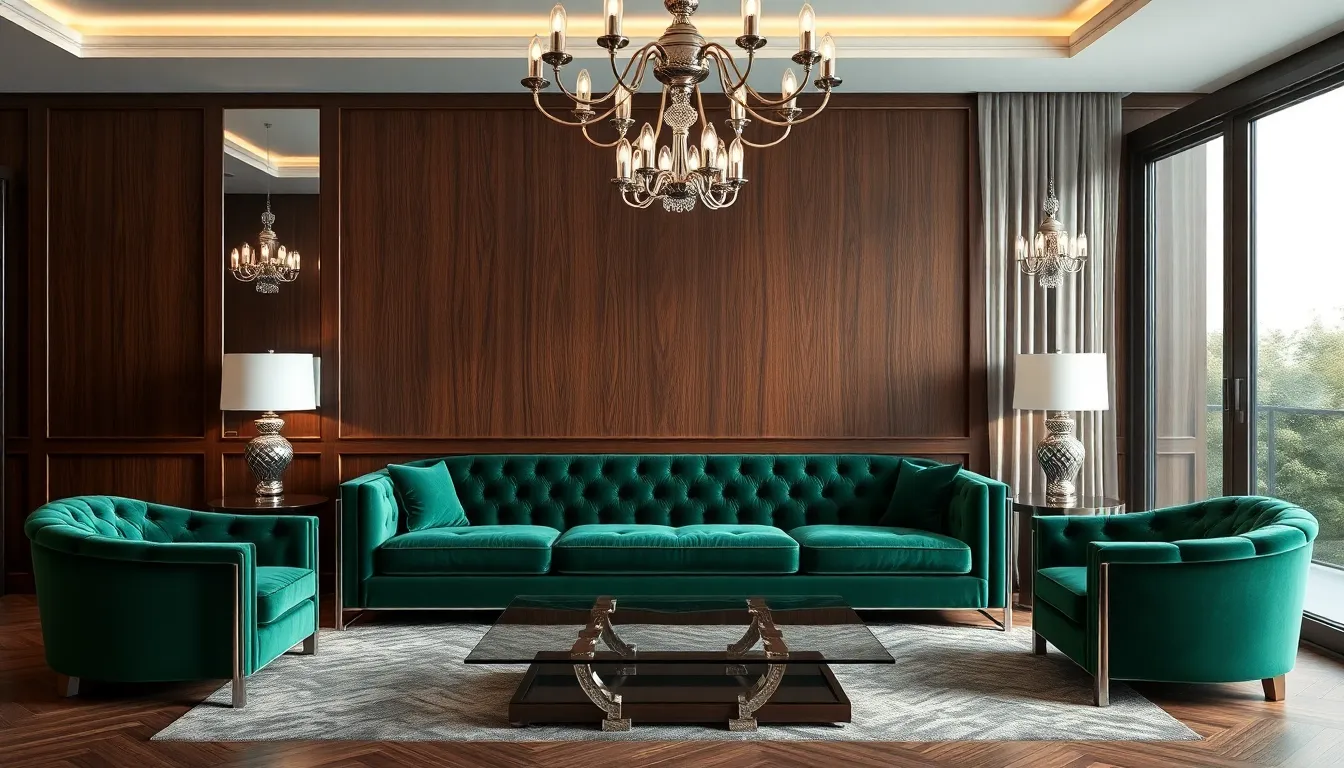Table of Contents
ToggleStep into a world where glamour meets geometry, and elegance dances with extravagance. Art Deco interiors aren’t just a design choice; they’re a lifestyle statement that screams sophistication while whispering, “I have impeccable taste.” This iconic style, born in the roaring 1920s, captures the essence of modernity with its bold lines, rich colors, and luxurious materials.
Imagine hosting a dinner party in a space that feels like a scene straight out of a classic film—where every corner is a conversation starter and every detail exudes charm. Whether it’s a sleek cocktail table or a dazzling chandelier, Art Deco transforms ordinary rooms into extraordinary experiences. So why settle for mundane when you can embrace the opulence of Art Deco? Let’s dive into this dazzling world and discover how to infuse your home with a touch of vintage glamour that even Gatsby would envy.
Overview of Art Deco Interiors
Art Deco interiors embody a harmonious blend of luxury and functionality, offering spaces rich with style and visual interest. This design movement draws inspiration from various influences, encapsulating diverse elements of artistry.
Historical Context
Art Deco emerged in the 1920s, marking a significant departure from previous design movements. It coincided with the economic prosperity of the Roaring Twenties, when optimism and modernity flourished. The style reflects advancements in technology and materials, which allowed for bold architectural and design choices. Cultural influences from Africa, China, and other regions also shaped the aesthetic. As a result, Art Deco became a global phenomenon, influencing architecture and design across continents.
Key Characteristics
Key characteristics define Art Deco interiors, setting them apart from other design styles. Bold geometric patterns, intricate details, and vibrant color palettes dominate these spaces. Luxurious materials, such as chrome, glass, and exotic woods, contribute to the overall opulence. Curved forms and streamlined shapes establish a sense of movement and fluidity. Lighting plays a crucial role, with sculptural fixtures serving as focal points. Together, these aspects create an atmosphere that exudes sophistication and timeless glamour.
Color Palettes and Materials

Art Deco interiors showcase a captivating interplay between color and texture, creating immersive environments.
Common Color Schemes
Daring color combinations define Art Deco aesthetics. Rich jewel tones, such as emerald green, ruby red, and sapphire blue, serve as focal points. Black and gold accents add a dramatic flair, enhancing the overall sophistication. Soft pastels, while less common, offer an elegant juxtaposition against bolder hues. Monochromatic schemes, incorporating varying shades of one color, create depth and intrigue. These color schemes work together to evoke glamour and luxury in any interior space.
Popular Materials Used
Art Deco design employs a variety of luxurious materials. Chrome and stainless steel reflect light, adding a modern sheen to rooms. Glass elements, including mirrors and decorative panels, contribute to an airy feel. Exotic woods, such as mahogany and walnut, offer warmth and richness. Upholstery fabrics like velvet and silk enhance comfort and visual appeal. These materials combine to create an opulent atmosphere, embodying the timeless elegance of Art Deco style.
Furniture and Decoration Styles
Art Deco interiors shine through their distinctive furniture and decorative elements. Each piece reflects the bold aesthetics and luxurious materials synonymous with this style.
Iconic Furniture Designs
Geometric shapes define iconic furniture designs in Art Deco. Chairs often feature sharp angles and sleek lines, showcasing the era’s emphasis on modernity. Love seats and sofas commonly incorporate luxurious upholstery like velvet, often in rich jewel tones. Selected pieces may include exotic woods and chrome accents, marrying form with function. Coffee tables frequently display glass tops, enhancing visual depth and elegance.
Decorative Elements
Sculptural lighting fixtures play a central role in Art Deco decor. Chandeliers and lamps often embody intricate designs and radiant materials, serving as statement pieces. Mirrors with geometric patterns add a sense of space and light, enhancing an open feel. Wall art frequently features bold colors and dynamic imagery, reflecting the vibrancy of the period. Accessories, such as vases and sculptures, often incorporate metallic finishes, harmonizing with the overall luxurious aesthetic.
Famous Art Deco Interior Designs
Art Deco leaves a lasting mark on interior design with its iconic spaces and innovative creators. Noteworthy designs capture the essence of this luxurious style.
Notable Buildings and Spaces
The Palais de Chaillot in Paris showcases stunning Art Deco interiors with intricate detailing and geometric motifs. The iconic Chrysler Building in New York features lavish lobby spaces adorned with bold colors and ornate metalwork. The Miami Beach Architectural District presents an array of hotels blending pastel hues with streamlined forms, creating vibrant and inviting atmospheres. Meanwhile, the artful interiors of the Radio City Music Hall reflect the grandeur of the 1930s, highlighted by striking murals and lavish furnishings. Each space not only represents Art Deco’s sophistication but also highlights the era’s commitment to style and craftsmanship.
Influential Designers
Renowned designers played a pivotal role in shaping Art Deco’s aesthetic. René Lalique is celebrated for his exquisite glasswork, creating stunning decorative pieces that elevate interior spaces. Émile-Jacques Ruhlmann, a master furniture designer, is known for luxurious pieces that seamlessly blend comfort with artistry. Jacques-Émile Ruhlmann’s furniture exemplifies the geometric lines and rich materials characteristic of Art Deco. Another influential figure, Paul Follot, contributed innovative designs that emphasized functionality while maintaining elegance. Together, these designers shaped Art Deco interiors to reflect a lavish lifestyle and artistic innovation.
How to Incorporate Art Deco Interiors Today
Incorporating Art Deco interiors into contemporary spaces adds a touch of timeless luxury and elegance. Eye-catching elements enhance the overall aesthetic of home design.
Tips for Home Design
Select bold geometric patterns for wallpaper or textiles to create visual interest. Rich jewel tones like emerald green or sapphire blue make perfect color choices for accent walls or upholstered furniture. Invest in iconic Art Deco furniture pieces, such as streamlined sofas and glass-topped coffee tables. Don’t forget to include sculptural lighting fixtures that serve as striking focal points. Accessories like metallic vases or mirrors with geometric patterns complete the look by reinforcing the distinct Art Deco vibe.
Blending with Modern Styles
Blend sleek, contemporary furnishings with vintage Art Deco elements to achieve a harmonious balance. Use neutral colors like white or gray as a base, allowing the vibrant Art Deco features to pop. Incorporate modern artwork alongside classic geometric designs to create a compelling dialogue between styles. Combining minimalistic accessories with decorative Art Deco pieces keeps the space feeling fresh and relevant. Emphasizing materials like chrome or glass in modern items enhances the overall luxury while respecting the original design ethos.
Embracing Art Deco interiors offers a unique opportunity to infuse spaces with timeless elegance and sophistication. This design style not only celebrates bold geometric patterns and rich colors but also reflects a rich historical narrative that continues to inspire modern aesthetics. By thoughtfully incorporating Art Deco elements into contemporary homes, individuals can create environments that are both luxurious and functional.
The allure of Art Deco lies in its ability to transform ordinary rooms into extraordinary settings. With the right blend of vintage glamour and modern sensibility, anyone can achieve a captivating atmosphere that invites admiration and appreciation. Whether through statement furniture or striking decorative accents, Art Deco remains a powerful choice for those seeking to elevate their interior spaces.




